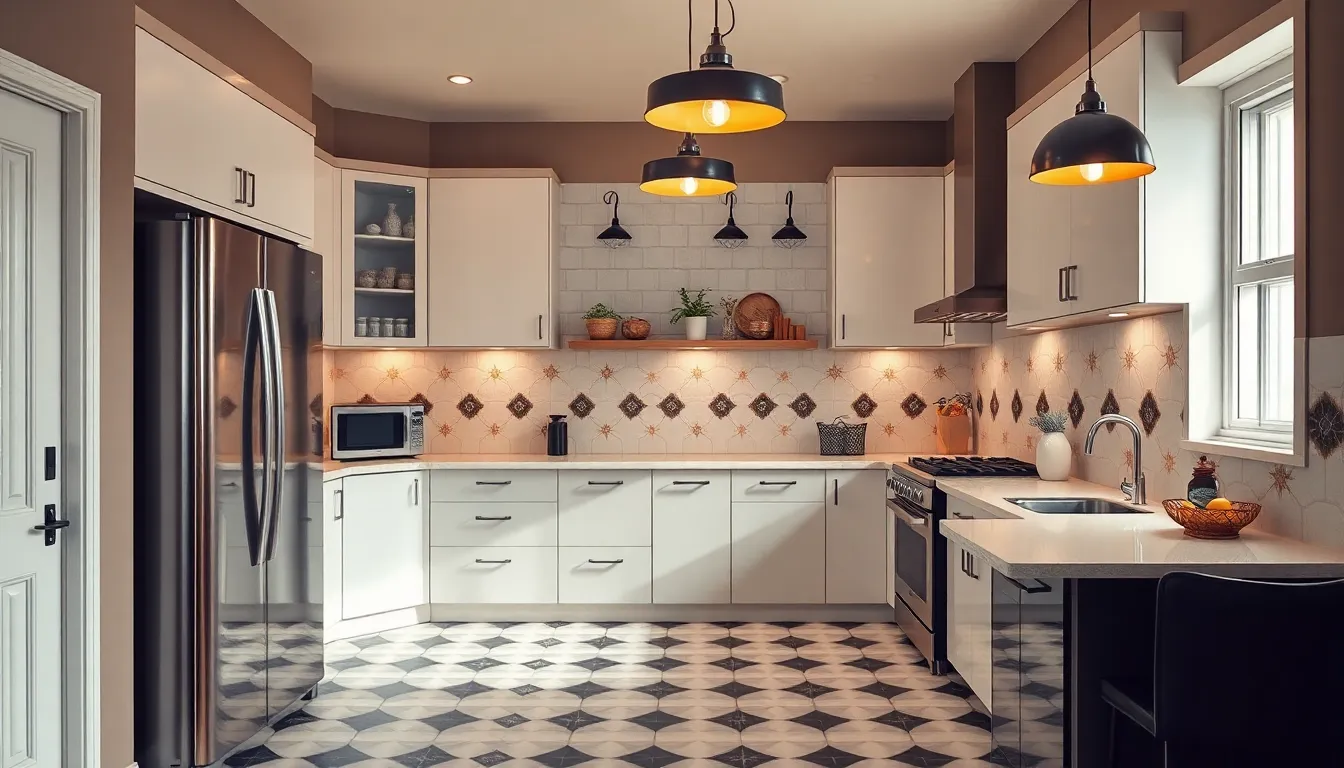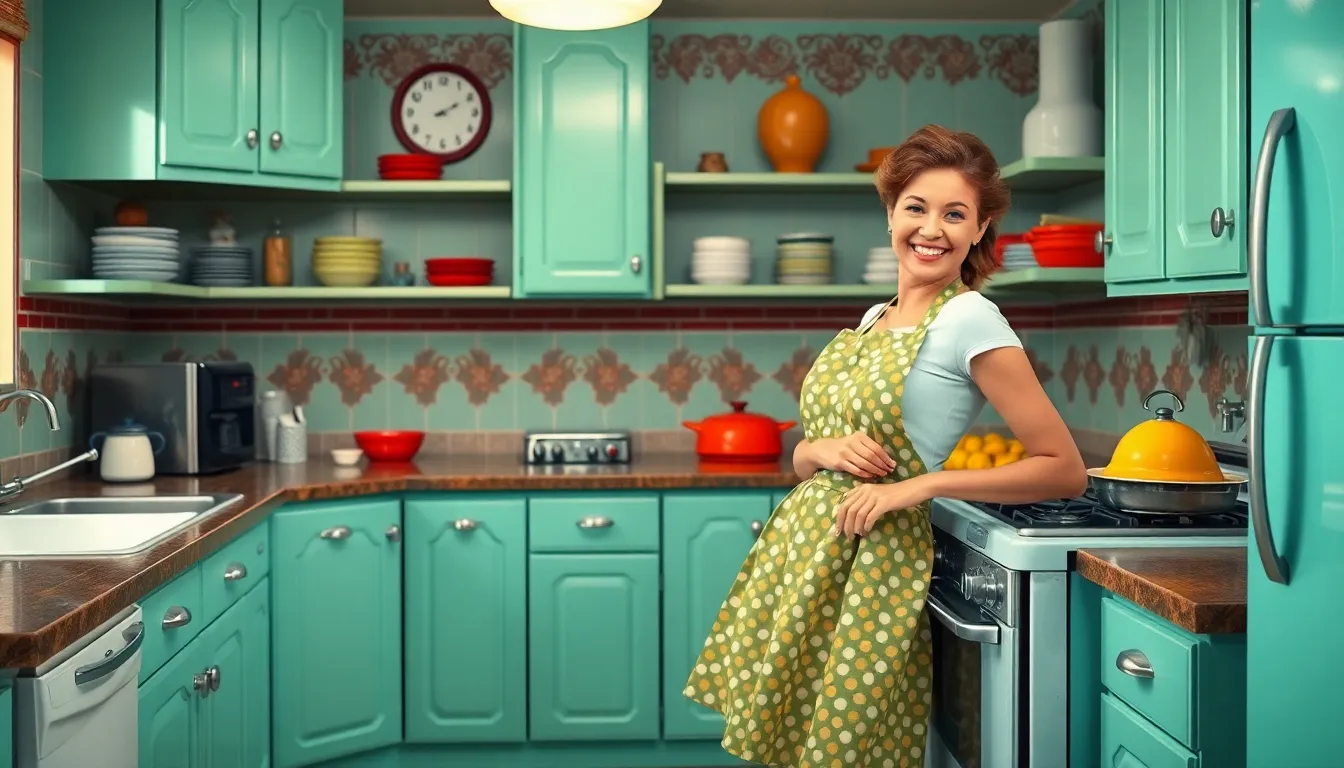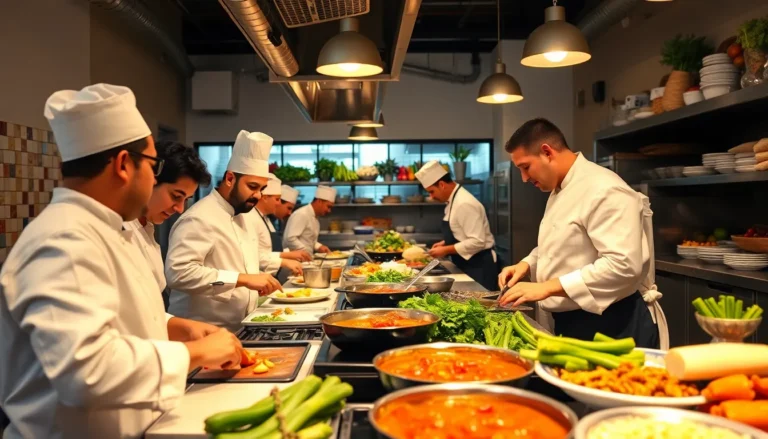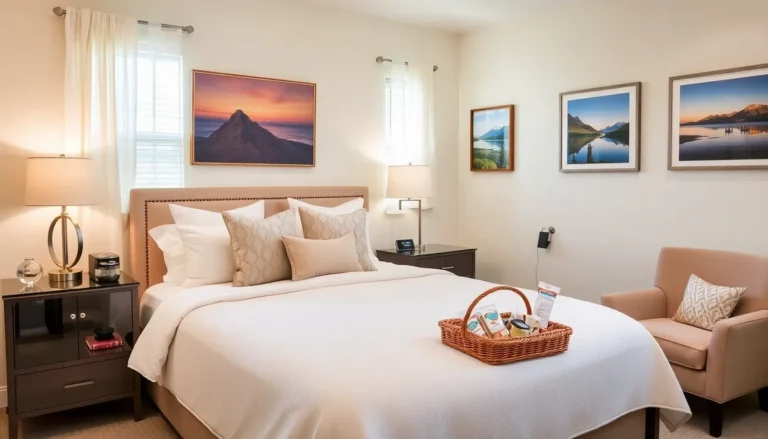Table of Contents
ToggleKitchens have always been the heart of the home, but they’ve also been a reflection of the times. From the retro charm of the 1950s to the sleek minimalism of today, each decade brings its own flavor to this essential space. Ever wondered why your grandma’s kitchen looked like a set from a sitcom? Or why today’s kitchens resemble something out of a sci-fi movie?
Overview of Kitchens Through The Decades
Kitchens have transformed significantly over the decades, mirroring cultural shifts and advancements in technology. The 1950s showcased retro designs with bold colors and chrome accents, symbolizing post-war prosperity and family-oriented living. Brightly patterned wallpaper and vibrant appliances brought a lively atmosphere to this era, where the kitchen became a social hub.
In contrast, the 1960s embraced a more eclectic style, incorporating open floor plans and experimental designs. People sought convenience, which led to the introduction of built-in appliances and innovative storage solutions. The space emphasized functionality while maintaining a trendy aesthetic.
The 1970s moved toward natural materials, featuring wood and earthy tones. Shag carpeting on kitchen floors and the infamous avocado-green appliances marked this decade. The focus on comfort and casual dining reflected changing lifestyles, as families spent more time together at home.
Fast forward to the 1980s, where kitchens became an extension of living areas. Country-style cabinetry and breakfast nooks emerged, promoting cozy gatherings. This period saw the increased popularity of gourmet cooking, and kitchens filled with high-end appliances reflected culinary aspirations.
During the 1990s and early 2000s, minimalism took the stage. Clean lines and muted color palettes defined this era, prioritizing simplicity and functionality. Open-concept designs became mainstream, as homeowners embraced spacious living and entertaining.
Today, contemporary kitchens continue to evolve, emphasizing smart technology and environmental sustainability. Energy-efficient appliances and eco-friendly materials play vital roles in modern designs. With a focus on adaptability, these kitchens cater to diverse lifestyles, bridging the gap between innovation and style.
The 1920s: The Birth of Modernism

Kitchen design in the 1920s marked a significant departure from traditional styles. Emphasis on functionality and simplicity began shaping modern kitchen aesthetics.
Design Trends
Art Deco played a crucial role in kitchen designs during this decade. Clean lines and geometric shapes dominated interiors. Bright colors, especially blacks, whites, and metallic hues, created striking contrasts. Streamlined furniture and built-in cabinetry started replacing ornate details. Industrial materials, like steel and chrome, gained popularity, reflecting the age’s fascination with technology. These design trends promoted an atmosphere of sophistication and modern living.
Key Features
Key features defined the 1920s kitchen. Open layouts increased accessibility and efficiency. The introduction of electric appliances marked a technological leap, offering convenience for home cooks. Built-in sinks and workspaces streamlined kitchen tasks. Decorative elements, such as patterned tiles and bold light fixtures, contributed to visual appeal. Efficient storage solutions emerged, accommodating the growing array of kitchen tools and utensils. Together, these elements forged a new identity for the kitchen, aligning with evolving lifestyles and societal changes.
The 1930s: Streamlined Comfort
Kitchens in the 1930s showcased streamlined comfort, blending functionality with modern aesthetics. This decade reflected a shift toward practical elegance in home design, emphasizing user-friendly spaces.
Popular Materials
Metal and wood dominated kitchen materials, creating a balance between style and durability. Porcelain enamel became popular for its glossy finish, while chrome fixtures added to the contemporary look. Colored tiles adorned backsplashes, bringing vibrancy to otherwise neutral palettes. Linoleum emerged as a go-to flooring option due to its affordability and ease of maintenance. These materials set the stage for kitchens that balanced comfort and modernity.
Appliances of the Era
The introduction of electric appliances revolutionized kitchen tasks. Refrigerators replaced iceboxes, enhancing food preservation. Electric stoves offered quicker meal preparation than traditional gas options. Stand mixers and toasters became common, streamlining everyday cooking tasks. Space-saving designs characterized these appliances, reflecting the efficiency-focused mindset of the decade. These innovations helped shape the modern kitchen lifestyle, making it more functional and inviting.
The 1940s: War and Innovation
During the 1940s, kitchens faced significant changes driven by World War II and subsequent innovations. War demands reshaped kitchen designs into efficient and multifunctional spaces.
Functional Design
Efficiency defined kitchen design in the 1940s. Space-saving layouts maximized utility with streamlined cabinetry and integrated appliances. Cabinets often reached the ceiling, accommodating storage needs without occupying additional floor space. Additionally, countertops featured durable materials like laminate and linoleum to withstand wear. An emphasis on ease of use led to the rise of built-in appliances, including ovens and refrigerators, which simplified meal prep. Designs catered to the needs of families adjusting to wartime rationing, reflecting a commitment to practicality.
Impact of Rationing
Rationing during the 1940s significantly influenced culinary practices. Limited availability of food items pushed families to rely on creative recipes. Cooks used staple ingredients, such as potatoes and rice, as the basis for meals. The government encouraged the preservation of homegrown produce, leading to an increase in home canning. Consequently, kitchens staged vibrant collections of jars filled with pickled vegetables and fruits. These alterations not only shaped the cooking environment but also fostered a sense of community through shared experiences in meal planning and preparation.
The 1950s: The Golden Age of Color
The 1950s epitomized a vibrant shift in kitchen aesthetics, blending bold colors with practical designs. This decade saw an explosion of personality in kitchen spaces, making them central to home life.
Iconic Styles
Many kitchens showcased pastel hues like mint green, soft pink, and buttery yellow. These colors often paired with glossy white finishes created a cheerful atmosphere. Curved lines and organic shapes reflected a departure from rigid forms, emphasizing comfort. Chrome accents highlighted appliances, creating a striking contrast against bold cabinetry. Formica countertops became staples, offering colorful options that combined style with ease of maintenance. Open layouts invited social interaction, fostering vibrant family gatherings.
Technological Advancements
Technological innovations transformed kitchen functionality during this era. Refrigerators and electric stoves became standard, simplifying meal preparation. Many appliances delivered both efficiency and eye-catching designs, with some featuring innovative features like dual ovens. Dishwashers emerged, revolutionizing cleanup processes for busy households. The introduction of modular cabinetry allowed homeowners to personalize layouts according to their preferences. These advancements not only enhanced convenience but also reflected the growing dependence on technology in everyday life.
The 1960s and 1970s: Open Spaces and Experimentation
Kitchens transformed significantly during the 1960s and 1970s, emphasizing open spaces and innovative designs. This era embraced fluid layouts, merging kitchen and dining areas. Many homeowners opted for large breakfast nooks and islands, enhancing social interactions. Such layouts allowed for ease of movement and multitasking. Designers integrated built-in appliances into cabinets, creating a seamless look. The shift toward open concepts redefined how families interacted, making cooking a communal activity rather than a solitary chore.
Changing Layouts
Open floor plans gained prominence during this time, encouraging a casual atmosphere. Kitchens became more than functional spaces; they turned into social hubs within homes. Openings between kitchens and adjacent living areas facilitated better traffic flow and interaction. Architecturally, walls often came down to create visually connected spaces. Flexibility in design allowed homeowners to tailor kitchens to their needs, promoting creativity in functionality.
Bold Colors and Patterns
Vivid colors dominated kitchen designs, reflecting the bold spirit of the era. Shades of avocado green, burnt orange, and mustard yellow became staples in cabinetry and appliances. Wallpapers featuring geometric patterns and vibrant motifs adorned walls, adding personality to spaces. Countertops even showcased bright hues, bringing an element of fun to kitchen aesthetics. Textiles, such as curtains and tablecloths, incorporated playful designs, heightening visual interest. Each color choice and pattern contributed to the eclectic and experimental vibe, setting the tone for kitchens in decades to come.
The 1980s and 1990s: Minimalism and Technology
The 1980s and 1990s marked a pivotal shift in kitchen design, emphasizing minimalism and advanced technology. This period set the foundation for modern kitchen layouts and appliance functionality.
Rise of the Kitchen Island
Kitchen islands gained popularity during the 1980s as multifunctional hubs. They provided additional counter space for meal prep and informal dining. Families utilized these islands for quick breakfasts and casual gatherings. Customized island designs emerged, offering storage solutions and integrated appliances. Expanding layouts, with islands at their center, redefined kitchen dynamics, encouraging social interactions. Open-concept designs allowed kitchens to blend seamlessly with adjoining living spaces, making them the focal point of homes.
Smart Appliances
The introduction of smart appliances revolutionized kitchen functionality in the 1990s. Innovations included refrigerators with internet connectivity and programmable ovens. Homeowners embraced devices that simplified cooking and meal planning. Timers and temperature controls became easily accessible through digital displays. Increasing focus on energy efficiency prompted manufacturers to integrate smart technology into everyday appliances. Smart appliances, alongside minimalist designs, transformed kitchens into efficient and user-friendly environments.
The 2000s: Eco-Friendly and Contemporary
Kitchens in the 2000s shifted towards eco-friendly designs and contemporary styles. Sustainable practices emerged as a priority, impacting material selection and overall design.
Sustainable Materials
Natural elements defined kitchen aesthetics during this decade. Bamboo, reclaimed wood, and recycled materials gained popularity for cabinetry and countertops. These sustainable materials offered both style and environmental benefits. Homeowners favored non-toxic finishes and low-VOC paints, promoting healthier indoor air quality. Many kitchens showcased energy-efficient appliances, which contributed to both energy savings and reduced environmental impact. Designers embraced modern yet timeless aesthetics, blending sustainability seamlessly into functional spaces.
Integration of Technology
Technology integration marked a significant transformation in kitchen design. Smart appliances became more common, enhancing convenience and efficiency. Features like touchscreen controls and app connectivity transformed cooking experiences. Homeowners enjoyed programmable ovens, which allowed for precise cooking times and temperatures. Refrigerators with built-in cameras enabled grocery management on the go. This decade also saw the rise of energy management systems, optimizing overall home energy use. Advances in kitchen tech fostered a blend of style and innovation, reflecting contemporary lifestyles.
Current Trends and Future Directions
Contemporary kitchens prioritize smart technology and sustainability. Energy-efficient appliances and smart home integration simplify cooking and enhance efficiency. Innovations like touchscreens and app connectivity provide homeowners with convenient culinary experiences.
Sustainable materials are now at the forefront of design. Bamboo, reclaimed wood, and recycled additives not only offer aesthetic appeal but also contribute to eco-friendly practices. Homeowners increasingly choose non-toxic finishes to improve indoor air quality.
Open floor plans continue to dominate kitchen layouts. These designs seamlessly connect cooking, dining, and social spaces, fostering interaction among family members. Kitchen islands often serve as multifunctional hubs, increasing workspace and informal dining options.
Color trends also emphasize earthy tones and minimalism. Shades of green, gray, and beige create a calm atmosphere while maintaining social functionality. Decorative elements remain vital, with stylish fixtures and patterns adding personality to spaces.
Future developments suggest a growing focus on versatility. Multi-purpose appliances and adaptable furniture can respond to the evolving needs of modern households. Sustainable practices are expected to integrate deeper into kitchen design, shaping future culinary spaces.
Health and wellness trends are pivotal as well. Kitchens may incorporate features that enhance cooking experiences, linking nutrition and culinary innovation. As technological advancements continue to emerge, kitchens will likely embrace new functionalities that align with contemporary lifestyles.
Kitchens have come a long way over the decades reflecting not only changing tastes but also advancements in technology and lifestyle. Each era brought its own unique flair and functionality shaping how families interact and prepare meals. As trends continue to evolve the focus remains on creating spaces that are both stylish and efficient.
Today’s kitchens embrace sustainability and smart technology making them more than just cooking areas. They serve as multifunctional hubs where families gather and connect. The journey of kitchen design showcases a blend of tradition and innovation promising exciting possibilities for the future.








